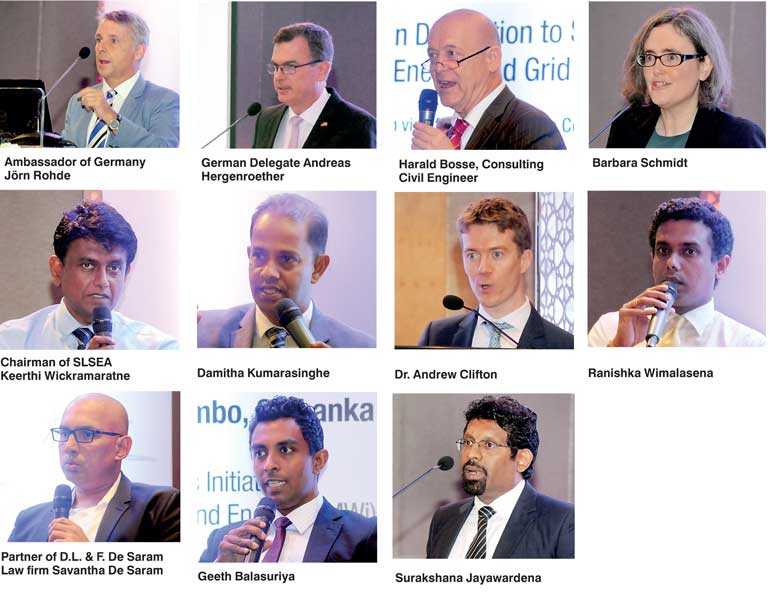Tuesday Dec 09, 2025
Tuesday Dec 09, 2025
Wednesday, 25 April 2018 09:00 - - {{hitsCtrl.values.hits}}

By Shanika Sriyananda
The Government, which is to embark on an ambitious plan to have a 60% energy mix entirely from renewable energy sources by 2030, has sought the assistance of the German government to find investors and overcome technical obstacles to renewable energy generation.
“Sri Lanka, in this journey to make this transition, needs lots of investment for the grid integration and also support to address technical issues,” said Public Utilities Commission of Sri Lanka (PUCSL) Director General Damitha Kumarasinghe.
Speaking at a conference on ‘Wind energy and grid integration’ held in Colombo yesterday, he said that Sri Lanka had huge potential to develop wind energy due to two reasons – the present penetration level of wind which is very low and the low prices here.
“Wind is supposed to be the cheapest energy source when you consider the tenders that we have closed recently,” he said at the conference organised by the newly-founded Delegation of German Industry and Commerce in Sri Lanka (AHK Sri Lanka), Indo-German (AHK India) and the Africa Pacific Association of German Business (OAV), and supported by the Ministry of Economic Affairs and Energy of Germany.
Kumarasinghe said that at the moment Sri Lanka had about 150 MW in wind power and 150 MW in solar energy and the Government intended to increase the renewable energy share from 40% to 60 % by 2030.
“There is huge potential in collaborating with the government and German companies for the strengthening of the grid and also coming up with solutions with the intermitted penetration resource level. That will lead to a very competitive, efficient and high-quality priced electricity supply,” he noted.
Addressing the gathering, Ambassador of Germany, Joern Rohde, said that it was a good opportunity, especially in the renewable sector, to intensify cooperation between the two countries, which share some common features like natural resources, increasing electricity energy demand, reducing greenhouse gases, decency on fossil fuels and concerns to develop more renewable energy sources.
While talking about Germany’s energy transition 10 years ago, with the country deciding to abandon nuclear energy since 2012 and develop renewable energy sources, he said the country had also made mistakes over the years, especially when it came to subsidiaries.
“Sometimes when you have subsidiaries too long they conserve structures which leads to market distortion,” he said, adding that Sri Lanka was the most developed country in South East Asia and yet it had one of the lowest fuel prices, which had led to market distortions.
He said that Sri Lanka and Germany were at the forefront of developing renewable energy using innovating technologies and Sri Lanka could benefit as German companies had expertise in the energy sector.
The conference was part of the ‘Renewables – made in Germany’ project of the German Ministry of Economic Affairs and Energy, which aims to enhance cooperation and knowledge transfer with countries committed to increasing renewable energy in their energy supply.
A German wind energy delegation and several local companies in the energy sector as well as experts participated in the conference, where Power and Renewable Energy State Minister Ajith P. Perera was the Chief Guest.Head of the South Asia Division of OAV (German Asia-Pacific Business Association), Barbara Schmidt-Ajayi, said that while covering the entire Asia Pacific region including China and India, OAV had also been concerned about promising smaller markets like Sri Lanka.
“15 German companies had visited the country in October 2016 to explore possible business opportunities in Colombo and Jaffna. We are very pleased that now Sri Lanka is one of the target markets and we will be able to gather some German companies with us this week to visit Sri Lanka to explore more opportunities to invest,” she said.
Director Development of the Ministry of Power and Renewable Energy, Surakshana Jayawardena, speaking about the efforts made by the Government and the Ceylon Electricity Board to develop renewable energy, especially wind energy, said that Sri Lanka was still in the early stages of developing wind energy, which has huge potential.
“According to a study done by the ADB, Sri Lanka has the potential of 5,000 MW of wind energy. We have only harnessed only 128 MW so far. The Government is planning to build large-scale wind power plants in Sri Lanka but we have some technical constraints as we have a comparatively small grid capacity,” he said, requesting German companies which have the requisite expertise to support the country’s energy sector.
He revealed the Government’s plans to develop 400 MW in wind energy by 2020 and also another wind energy plant to generate 900 MW by 2030.
“We also have plans to develop a 1,300 MW wind power plant by 2036 but need to overcome technical issues, need to find a huge investment and also need to develop the transmission network to meet this target,” he said.
pix by Gitika Talukdar